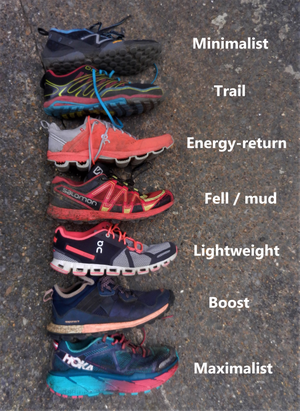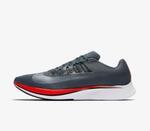Minimalist vs. Maximalist
Minimalist and Maximalist Running Shoes: How do you compare?
With over 150 brands out there and a further range of running shoes within these brands there are lots to pick from. So how do you or should you compare running shoes?
Minimalist and Maximalist Running Shoes?
A topic of fierce debate over the years is between minimalist and maximalist running shoes. The running warehouse guide in my opinion summarises it quite well. “If you feel beat up after running try going down a stack height (what’s between you and the ground), if you need more speed try going up one.” The distance and terrain you are running on are worth considering too.
Minimalist Running Shoes
Key Features
- Low stack
- Low heel drop
- High flexibility
- No motion control or stability devices
- Lighter shoe
Brands
- Nike Free
- Vibrum
- NB Minimus
Maximalist Running Shoes
Key Features
- Cushioning (high stack)
- Heel drop
- Motion control
- Motion control features
- Heavier
Brands
- Under Armour Fat Tyre
- Tecnica
- NB 1080
Which Running Shoes are Most Popular?
At the 2016 Iron Man World Championships a survey reported by LAVA Magazine found the preferred brand of trainers, chosen by participating athletes, to be HOKA (18.1%), Saucony (12.6%) and Asics (12.4%). From the list of brands included, minimalist shoes such as Vibrum made up less than 1% of the trainers worn by athletes. Runners World recently published the top sales in mens running shoes which the top 5 are listed below.
- Nike Zoom Fly

- HOKA ONE ONE clifton 4
- HOKA ONE ONE Clifton 4
- HOKA ONE ONE Bandi 5
- Altra Escalante
(source: Runners World 2017)
So what can we gather from that? Well I guess it’s fair to say running shoes are bought based on the runner’s experience of the shoe and you could deduce that a maximalist running shoe is preferable right now based on sales. However energy return is the current hot topic in running shoes and brands such as the Nike Vapour Fly have many similar features to a maximalist running shoe.
Should Running Style Influence Your Running Shoe?
Barefoot runners or those who wear minimalist shoes tend to be mid-foot strikers and those runners who tend to wear more traditional running shoes with cushioning tend to be heel strikers. Mid-foot strikers tend to have reduced loading on the knee but increased loading on the ankle joint and vice versa when compared with heel strikers.
There are lots of different experiences and anecdotes from those that use both. However a study by Grace et al 2017 which was published in Footwear Science compared comfort and sensitivity in the sole of the foot when wearing minimalist and maximalist running shoes and found participants who were sensitive to mechanical pain at their heel and lateral mid foot preferred the cushioning shoe. So should this be a key consideration for the runner when purchasing a minimal or maximalist shoe? Well that depends on your experience of running and your current shoe.
In contrast, a study by published in the International Journal of Exercise Science reviewed the influence of biomechanics before and after a 5K run in neutral and maximalist shoes. This study found increased loading on the sole of the foot in maximalist shoes which would indicate you hit the ground harder in these shoes increasing load, but it is important to remember there is no evidence that I am aware of that would correlate this with an increase in the risk of injury.
What About Your Weight?
A study by Fuller et al concluded that weight should be a consideration and those above 75kg would be more likely to get injured in a minimalist running shoe, this increased to over 3 times if your weight is above 85kg and if less than 71kg there would be no difference in risk of injury. So a maximalist shoe may be a good idea to start out on if you’re overweight.
When Should You Use a Minimalist shoe?
I think it’s fair to say currently maximalist trainers are most popular, but it’s worth considering when a minimalist shoe may be preferable.
- When changing running style in consultation with your health practitioner
- If you prefer a feel for the road
- Conditioning as part of your exercise programme
- Running on the flat
Top Tips?
In my opinion:
- Don’t fix what’s not broken...
- Don’t do it because everyone else is...
- Be careful what you read. There lots of information out there based on preferences rather than robust evidence...
- If you do wish to change running shoes or style have a well structured transition period to minimise the risk of injury...
- Perhaps, more importantly test it and see what you feel best running in...
To finish this piece I think the quote below is relevant to this very complex topic:
"Different running techniques and different running shoes load different tissues differently in different runners"
Craig Payne
To get further updates and tips from Podiatry Shetland why not follow us on Facebook, Pinterest, Twitter and Instagram
